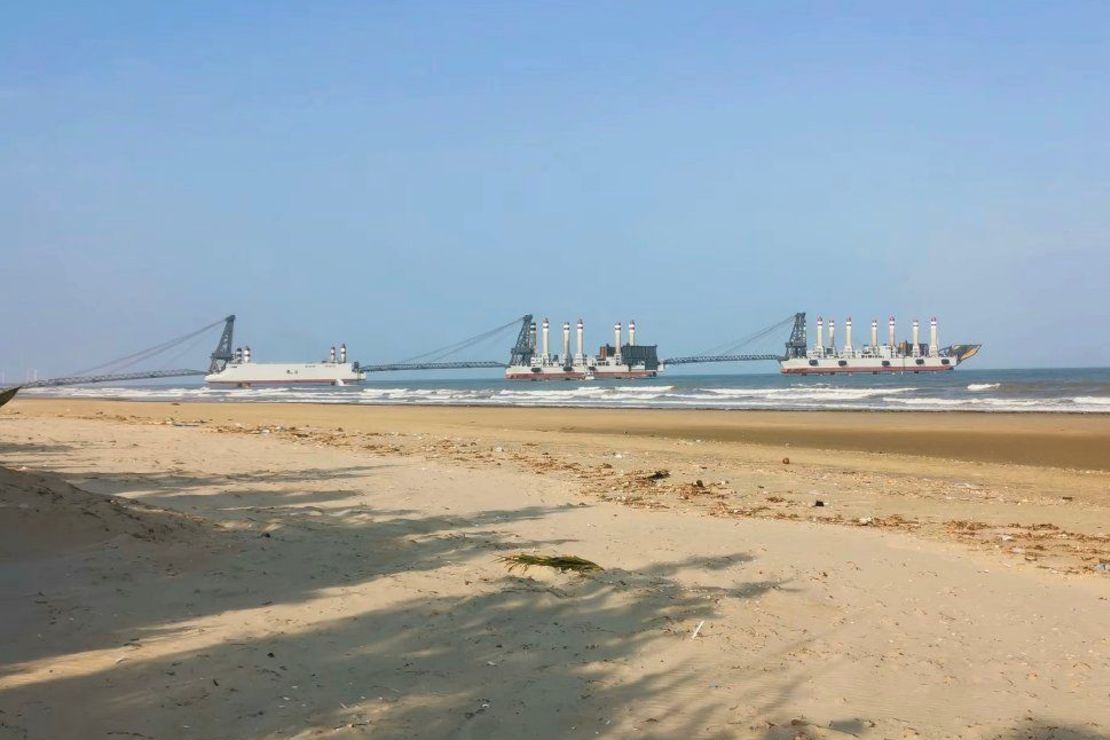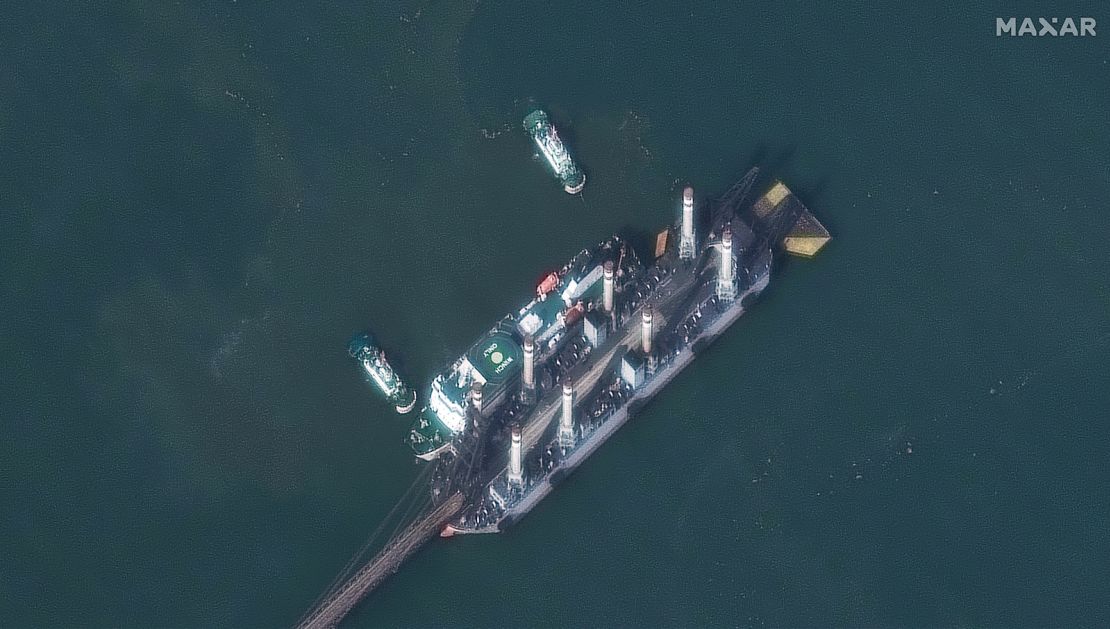Hong Kong/Taipei
CNN
—
From a chain of massive barges stretching from a Chinese beach into the sea, to a powerful new design for cutting undersea cables at record depths, China’s latest maritime innovations have captured the attention of defense experts – fueling concerns about their potential role in a future invasion of Taiwan.
While these new tools may ostensibly have civilian uses, experts say they highlight China’s expanding military and technological prowess – at a time when the ruling Communist Party is ramping up pressure on Taiwan, the self-governing democracy it claims as its own and has vowed to seize by force if necessary.
China already sends fighter jets and warships near the island almost daily and stages increasingly frequent military drills to intimidate what it calls “Taiwan separatist forces.”
Meanwhile Taiwan is looking on nervously as US President Donald Trump transforms Washington’s global relationships with his mercantilist “America First” foreign policy, discarding decades-old guarantees towards Europe and pushing long-standing Asian allies and partners to pay more for US protection.
Footage of the landing barges first surfaced – then quickly vanished – on Chinese social media this month, showing three enormous vessels stationed off a sandy beach strewn with seaweed, fishing boats and a handful of scattered tourists.
The three barges stood above the water on sturdy legs and were linked by bridges to form one giant causeway that stretched from the beach to more than 800 meters from the shore.
CNN has geolocated the video to a public beach near Zhanjiang, a port city in China’s southern Guangdong province and home to the headquarters of the Chinese navy’s South Sea Fleet. Satellite imagery has since confirmed their location.
Defense analysts J. Michael Dahm and Thomas Shugart said the barges constitute a “significant upgrade” to the amphibious assault capacity of China’s People Liberation Army (PLA). In the event of an invasion of Taiwan, they could form a relocatable pier, delivering large amounts of tanks, armored vehicles and other heavy equipment – once fire superiority has been established.
“The innovation really is the volume that they could potentially put onto a remote beach or a damaged port or an austere landing area, probably in excess of hundreds of vehicles per hour, if they chose to do that,” said Dahm, a retired US Navy intelligence officer and senior resident fellow at the Mitchell Institute for Aerospace Studies.
Shugart, a former US submariner and adjunct senior fellow at the Center for a New American Security, noted the barges add to a growing list of innovative platforms, munitions and weapon systems the Chinese military has tested in recent years.
“There’s nothing like them in the West. I have never seen anything like what we’re seeing here,” he said.
CNN has reached out to China’s defense ministry for comment.
Taiwan’s defense ministry said it had assessed that the new barges were “designed with an extendable ramp to serve as a makeshift dock, enabling the rapid offloading of main battle tanks and various vehicles in support of amphibious operations.” It said it would continue to monitor the barges and assess their capabilities and operational limitations.
Meanwhile, Chinese researchers from state-affiliated institutions claimed to have developed a powerful deep-sea device: a cable cutter capable of severing heavily fortified communication and power lines at depths of up to 4,000 meters – nearly twice the depth of the world’s deepest undersea cable.
The new design, published last month in the peer-reviewed Chinese journal Mechanical Engineer and first reported by the South China Morning Post, emerges amid growing concerns over the vulnerability of Taiwan’s critical infrastructure. Recently, suspicious damage to the island’s undersea cables has fueled fears of Chinese efforts to undermine the island’s communications with the outside world.
Collin Koh, a research fellow at the S. Rajaratnam School of International Studies (RSIS) in Singapore, said cable-cutting tools are commonly used for maintenance, and a breakthrough in the ability to sever cables at record depths with great efficiency isn’t alarming in itself.
“But what is alarming here is the political context that we attach to it,” he noted, pointing to recent incidents of undersea cable damage involving Chinese vessels around Taiwan and in the Baltic Sea.
The concern is that in the event of an invasion, China could sever the undersea cables around Taiwan, sowing panic among its public and potentially disrupting the island’s military communication with the US and other partners.
But Koh pointed out that the new cable-cutting design may have existed so far only in the experimental stage. “Whether it has translated into operationalized tool for use is a big question mark,” he said.

The video of the landing barges offered the first close-up look at what the Naval News reported in January as “special and unusual barges” spotted at Guangzhou Shipyard. The outlet described them as reminiscent of Britain’s Mulberry Harbors, which were built for the Allied invasion of Normandy during World War II.
While some analysts suggest the barges could serve civilian purposes such as humanitarian relief, many experts – both in and outside Taiwan – believe they were built primarily for a military purpose.
Su Tzu-yun, a director at the Institute for National Defense Security Research in Taiwan, said the barges could offer the PLA a strategic advantage by creating makeshift costal landing points – particularly if Taiwan destroys its own ports in self-defense in the event of an invasion.
“Such barges have six or eight hydro feet that can lift them out of the water to create a stable platform, and then they can create a bridge from shallow water to a deeper area,” Su said.
Shugart, the former submariner, said the barges could even potentially drop a ramp across seawalls or other obstacles onto a coastal road, allowing the PLA to send troops and equipment to shore.
He added that the barges also enhance operational speed. “We’ve seen them set up and broken down and set up again multiple times within a matter of days,” Shugart said, citing satellite images.
However, due to their size and slow speed, these vessels are highly vulnerable to enemy fire and would likely only be deployed as part of a second wave, following the initial landing forces across the Strait, which is around 80 miles wide at its narrowest point, experts say.
“Before they even think about embarking a landing force and sending troops across the (Taiwan) Strait, they would already make sure that they have seized air, information and naval dominance all the way across the strait,” Shugart said.
The barges “wouldn’t be brought forward until the environment had been made safe for them, just like in World War II D-Day, the US had complete air control and sea control before the landing forces went ashore,” he added.
Collin, the expert at RSIS in Singapore, said the barges are not designed for high intensity warfare at sea.
“They are slow, they are not so well protected on their own, and they require escorts, which must go at the same speed as those barges. And for some of the war fighting assets, speed is the essence,” he said.
Days before the video of the barges surfaced on Chinese social media, the Marine Safety Administration of Guangdong province issued a notice banning ships from entering a long, narrow body of water due to “maritime tests.” The geo-coordinates of the restricted zone matched the location of the barges confirmed by satellite imagery.
CNN has reached out to the Guangdong government agency for comment.

By March 21, satellite imagery from Maxar Technologies showed that the barges had moved about 15 kilometers south along the coast. The images also captured a roll-on/roll-off (RO-RO) ferry docked beside the third and largest barge, positioned farthest from shore. Days later, a Planet Labs satellite image showed another RO-RO cargo ship approaching the same barge from the opposite side.
According to Shugart, Chinese authorities may be testing the barges’ ability to interface with civilian RO-RO vessels, which could significantly boost the PLA’s sealift capabilities by enabling the rapid transfer of large numbers of wheeled and tracked vehicles.
Designed to transport large numbers of vehicles to overseas markets, RO-RO ships have proliferated globally, but especially in China in recent years to meet the surging global demand for Chinese electric vehicles. But Chinese military planners and state media have also taken note of their dual-use capabilities to support the PLA’s operations.
In a 2021 military drill, China’s state broadcaster CCTV praised RO-RO ferries for enabling “large-scale, full-unit land and sea deployment with immediate unloading and loading.” Footage aired by the broadcaster showed rows of tanks neatly lined up inside such a ferry.
“These barges can significantly improve the PLA capability to deliver logistics following an invasion,” said Dahm, the former US Navy intelligence officer.
But he noted they are only part of Chinese leader Xi Jinping’s ambition to modernize the PLA and transform it into a “world class” military.
American officials believe Xi has instructed the PLA to be ready to invade Taiwan by 2027, though they have stressed that doesn’t mean an invasion will occur in 2027.
“In the context of all of the other improvements that we’re seeing to PLA capabilities and especially to PLA infrastructure, the barges are just the shiny object that draws attention to the fact that the PLA is making these preparations to be prepared to act on Xi Jinping’s orders in the next several years, if called upon to do so,” Dahm said.

